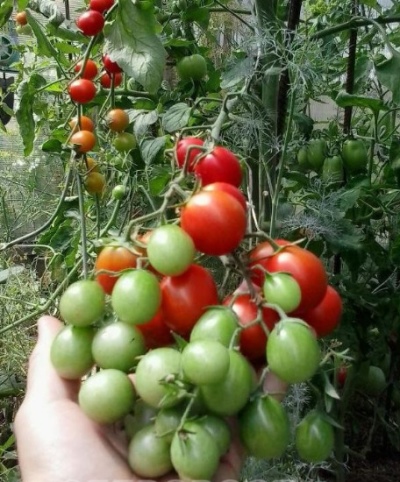
- Name synonyms: Barberry F1
- Category: hybrid
- Growth type: indeterminate
- Appointment: fresh consumption, for whole fruit preservation
- Ripening period: early
- Ripening time, days: 85-90
- Growing conditions: indoor, greenhouse, decorative gardening
- Bush size: tall
- Bush height, cm: 200-250
- Foliage: weak
Hybrid tomato varieties have fans and haters alike. However, this is precisely why it is important to understand the features of specific types in order to get the most adequate output. It is necessary to familiarize yourself with the tomato Barberry.
Description of the variety
This plant is a prominent representative of the group of indeterminate hybrids. It is noteworthy that such a culture can be used both in fruit gardening and for the purpose of decorating plots. She develops high (reaching 2-2.5 m) bushes. The number of leaves on Barberry is relatively small. They do not represent anything remarkable, differ only in stickiness.
The main qualities of the fruit
Barberry berries are typical cherry. When ripe, they are red in color. The average weight of the fetus is only 0.02 kg. It is characterized by a rounded shape. The share of dry matter ranges from 10 to 11%.
Taste characteristics
Tomato Barberry is praised for its very sweet taste. In this respect, it is a confident competitor to many large-fruited tomatoes. The pulp in the berries will be consistently dense and fleshy. The share of sugary substances reaches 7.5-8%. Some sources write about a slight sourness.
Ripening and fruiting
The variety belongs to the early category. On average, it takes from 85 to 90 days between the emergence of green growth on the surface and the readiness to harvest. But here both actual weather conditions and cultivation in the open air or in greenhouses can affect. Under favorable conditions, picking tomatoes will be possible until the end of August.
Yield
The usual collection will be 6-7 kg per 1 m2. The achievement of such a result will not require any special problems. Up to 100 fruits can grow on 1 brush. That is why excellent decorativeness of the landings is provided. There are indications in individual sources that with exemplary care, it is possible to guarantee the collection of 10 kg of berries from 1 bush per season.
The timing of planting seedlings and planting in the ground
Seeds are placed in containers in April or March. The time to plant seedlings in open ground comes 50-60 days after sowing. It is necessary to focus on the condition of the growth itself and on the actual weather.

Growing tomato seedlings is an extremely important process, because it largely depends on whether the gardener will be able to harvest at all. All aspects must be taken into account, from seedbed preparation to planting in the ground.
Landing scheme
In this regard, Barberry does not require you to come up with anything extraordinary, allowing generally accepted solutions to be dispensed with. The usual planting density is 3 or 4 bushes per square meter. m. As in the case of other varieties, it is important to take into account the peculiarities of the formation of specific plants. Most often, the culture is formed in 1 stem. This approach allows you to choose the tightest fit.

Growing and care
On each barberry brush, the fruits will ripen evenly over time. It is advisable to keep seedlings in a greenhouse at a temperature of 23-25 degrees. The soil for open planting is fertilized in advance. Due to the high height of the bushes, a garter is absolutely obligatory. It is necessary to water the plants strictly at the root, excluding the ingress of moisture on the open areas of the tomato.
Watering Barberry needs daily. But at the same time, excessively active irrigation should be excluded. Hilling is carried out periodically. The decorative qualities of this variety make it possible to grow it near walls, arches, arbors. Can Barberry decorate the most ordinary fence. Fertilizers are used at least 3 times per season:
- when 10 days have passed after planting seeds for seedlings;
- after the dissolution of the second brush and the formation of the ovary;
- as soon as the first crop of tomatoes is harvested.




A plant needs different micronutrients at each stage of growth. All fertilizers can be divided into two groups: mineral and organic. Folk remedies are often used: iodine, yeast, bird droppings, eggshells.
It is important to observe the rate and period of feeding. This also applies to folk remedies and organic fertilizers.
Disease and pest resistance
Barberry perfectly resists viral infections of tomatoes. According to gardeners, this plant also has good immunity to fungal attack. Air humidity of more than 65% must not be allowed, otherwise the culture may suffer. You will also have to remove and suppress weeds. If the rules of care are violated, it is likely that it will be affected by late blight or rot.



























































































